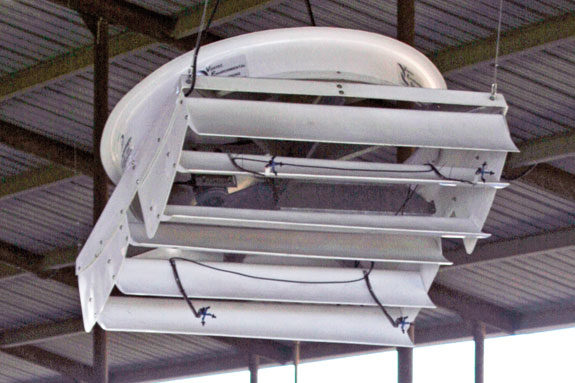For the past 18 months, “tighten your belts” has been the theme of hundreds of articles, conversations and presentations. At the same time a major trend around the world is to reduce energy consumption and find ways to be more efficient. There is a solution to cow comfort that actually accomplishes both of these concepts. Bob and Gary Marchy of Ceres, California, have installed 16 new 72-inch Cyclone fans, created by Ventec Environmental Solutions, in their 680-foot-long freestall barn. The dairy converted to a freestall system from an open lot system in 2008. Now they are trying to make the cows even more comfortable in the freestall by adding these new fans.
“We wanted more consistent milk production, breeding and more comfortable cows,” says Gary Marchy, who is a managing partner with his brother.
The brothers are quick to say they aren’t looking for more production – just smoother summers.
“It’s not that we want to make more milk – just not lose as much when it gets hot,” Bob Marchy says. “We are trying to minimize the big hits from high temperatures.”
The Marchys say that their summers are not as bad as some places, but it can get hot. Actually the average summer high in 2009 was 93ºF in the Modesto area near Ceres, with an average humidity of 44 percent. That is well above comfortable for dairy cows and Marchy Dairy has felt the impact. The soaker lines they installed last year didn’t do enough to stop the drops in milk production when the heat came on.
“Last year we would lose 1/4 to 1/2 a gallon of milk per cow on the hot days,” Bob Marchy continues. “They would bounce back pretty quick because the nights are usually pretty cool. But when the nights were hot too, the cows would have depressed production for awhile.”
Their conception rates were suffering from the heat, too. The Marchys’ dairy had conception rates ranging from 24.09 percent to 21.31 percent in 2009. They are hoping for more steady conception and easier transition with a more comfortable environment.
Technology has helped the industry improve efficiencies for 40 years. Despite the size and the amount of wind they create, the new fans are very energy efficient. Daniel Daccarett, with Dairy Technologies in Madera, California, says that these fans will run on nearly half the energy other smaller fans would use. He estimates that the Marchys will be able to cool their 650 cows for about $30 a day during the summer.
There are also fewer fans and a lot less noise in the freestalls.
“It would have taken 34 of the 50-inch fans to circulate the air in this freestall barn,” Bob Marchy says. “In talking with our vet, he couldn’t believe how quiet they are. He said that you can hardly have a conversation when the little fans are going.”
The six deflectors on each fan help to distribute the air more efficiently. In the Marchys’ freestall, fans were positioned every 75 feet, with air flowing up to 100 feet out and 35 feet wide. One fan can cool about 3,500 square feet. The fans also have a variable speed option that makes them even more efficient. The fan will consume 2200 watts of electricity at high speed and as little as 300 watts on low speed.
This technology has actually been around for a few years, but this is the first dairy in the Western U.S. to use it. There are many farms throughout the Midwest, and Northeastern U.S. that have installed the fans, as well as dairies throughout Canada, China and Mexico. These fans are becoming even more popular because many electric companies are offering rebates. However, rebates don’t mean much if the products don’t work.
“The rebate was an added benefit, but it wasn’t a factor in the decision,” says Gary Marchy. “Whatever we get is a bonus. We wanted more consistent milk production, breeding and more comfortable cows.” PD
Are you ready for this technology?
1. Are you looking for a cooling system in your freestall?
2. Are you looking for more efficient fans?
3. Do you want more airflow in your freestall?
4. Are your cows losing production in the heat of the summer?
5. Are your energy bills for the freestall too high in the summer?
6. Do you want to cash in on some “Eco-friendly” rebates?
7. Do you want to increase the pregnancy rates during the summer?
8. Do you want less noise in the barns when the fans are on?
9. Are your cows startled by noisy fans?
10. 10. Do you want to improve cow comfort on your dairy?
If you answered yes to seven or more of these questions, this technology may be one for you to consider.
PHOTO : One fan can cool about 5,250 feet. The fans also have a variable speed option that makes them even more efficient. Photo by PD staff.





